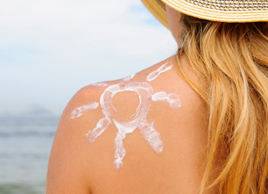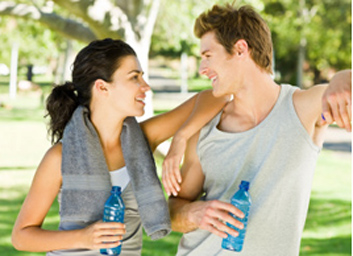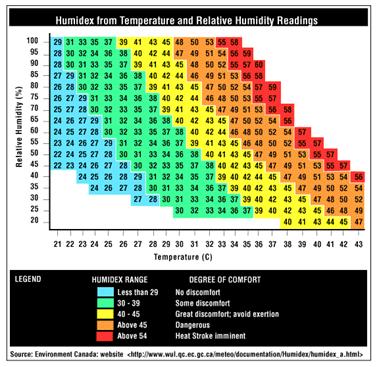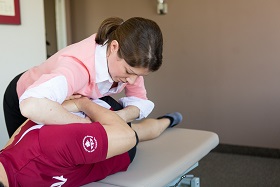
Critical Steps to Maximizing Athletic Performance in the Summer Heat
The hot and humid days of summer are approaching! The summer heat and humidity can increase risk of dehydration and impair performance as the body protects itself. However, with the right preparation you can not only survive these conditions but perform at your best.
How can I maximize my performance?
Preparation: like with many things in life prevention is better than a cure. Whether you're just starting out or you're a seasoned pro, here are a few simple steps that will help you beat the heat:
![]() Check the weather
Check the weather
- Temperatures of 18°C and higher can cause heat injury
- Humidity higher than 50%can impair the cooling effect of sweating
- Wind speed and direction influence heat loss (e.g. high head wind will cool but low tail wind may have no cooling effect)
![]() Use sun block
Use sun block
- Avoid getting sun burned as that will decrease your resistance to the heat
- Most affected or often burned are tops of shoulders, forearms, back of neck, calves, etc.
- Use SPF 60 that is sweat proof and reapply at 1-2 hour intervals
![]() Dress to impress
Dress to impress
- Wear clothing that is light (in both colour and weight) and porous(e.g. singlet, shorts)
- Dry fit or other wicking materials
- A light hat can help keep your head cool
![]() Know your limits and get familiar with hot weather conditions (heat acclimatization)
Know your limits and get familiar with hot weather conditions (heat acclimatization)
- Exercise intensity is a major contributor to body heat. Body temperature increases as exercise intensity increases - this affects our ability to stay cool
- Gradually increase exercise intensity and duration when exercising during the first few weeks of summer heat
- A week or two can go a long way to help prepare you for the rest of the summer
![]() Plan your route
Plan your route
- Tree-lined paths that provide shade will keep you out of direct sunlight and keep you cool

![]() Have a station for hydration, and don't forget to sponge
Have a station for hydration, and don't forget to sponge
- Sponging involves lowering the skin temperature with cool water or towel
What should I do to stay hydrated?
Humans live in a perpetual state of dehydration and are unable to exercise if dehydrated by more than 10% of body weight. It is common for athletes to lose 2% to 6% of their body weight during practice or competition in the heat. Water affects athletic performance more than any other nutrient. Consuming fluids in sufficient amounts is essential for normal muscular function. Most athletes only replace about two thirds of the water they sweat off during exercise - this is called voluntary dehydration. The level of dehydration attained depends on what you drink and when you drink it:
![]() Before Exercise
Before Exercise
- Hydrate 2 hours before exercise by drinking 500 ml (2 cups)
- For exercise longer than 45 minutes drink 150-250 ml (1 cup) 20 to 25 minutes before the start time - it will hydrate but will have no sloshing effect
![]() During Exercise
During Exercise
- Drink something that will absorb rapidly and is palatable (e.g. cool water or sport drink)
- The carbohydrates and electrolytes in sport drinks (e.g. Gatorade) are more likely to benefit performances lasting longer than an hour
- Carbohydrates are simple sugars that are easily digested to fuel the body in athletic performance. Glucose is a simple sugar.
- Electrolytes refer to sodium, potassium, chloride and magnesium. They are essential to muscle contraction and nerve conduction
- 1 L per hour or 250 ml (1 cup) of fluid every 15 minutes is the most you can expect your body to absorb
- During exercise that has shifts or breaks in play (hockey, ultimate frisbee, etc) take a drink after each shift
- During continuous exercise, drinking 200 to 400 ml per hour is more appropriate
- Don't experiment with new routines or sports drinks the day before or day of an important race, game or competition.
![]() After Exercise (during recovery)
After Exercise (during recovery)
- The goal is to prepare the body for the next day of training. Drink to rehydrate as well as replenish (electrolytes), refuel (carbohydrates) and repair (protein)
- Chocolate milk, Ensure, soy milk, V8, and sports drinks (e.g. Gatorade) will work
- Monitor sweat rate and dehydration to ensure you are properly hydrated
- Drink a carbohydrate and protein drink within 15 minutes of finishing exercise. Eat a meal with carbohydrates (e.g. pasta, rice) within 45 minutes post exercise to replenish your energy stores for the next day.
How do I monitor dehydration?
Try to stay well-hydrated. Once you are dehydrated your athletic performance has already been negatively affected. You can monitor your hydration status in a few simple ways:
![]() Colour of urine
Colour of urine
- Lightly coloured urine is the best measure of the optimum hydration state
- Dark yellow coloured urine that is strong smelling is a sign of dehydration
- Bright yellow coloured urine that is strong smelling could be from taking supplemental vitamins
![]() Frequency of urination
Frequency of urination
- We normally urinate about 1.1 L per day, or approximately 250 ml four times a day
- Rapid increases in heat or sweating can drastically reduce this amount
![]() Measuring fluid loss from exercise
Measuring fluid loss from exercise

- Measure weight (kg) with minimal clothing - remove wet clothing, socks and shoes
- Each pound (1kg = 2.2lbs) lost during exercise represents 500 ml of fluid loss
- Understanding water loss for different types of workouts and in different environmental conditions can help you plan how to hydrate to perform your best despite the heat and humidity
- Dehydration should be no greater than 2% to 6% of your body weight during practice or competition in the heat

Degree of comfort for temperature and humidity are based on comfort at rest or with minimal activity. Exercising in the heat causes additional strain or heat discomfort on the body and this chart should be used as a guideline.
Where can I get more information?
With the right preparation you can beat the heat this summer. For a personal plan to maximize your performance in sport or stay healthy and physically active in the heat, call our clinic (613-521-3222) and speak with David Witiluk, Registered Kinesiologist.
Click here for our quick reference Hydration Guide.

Critical Steps to Maximizing Athletic Performance in the Summer Heat
The hot and humid days of summer are approaching! The summer heat and humidity can increase risk of dehydration and impair performance as the body protects itself. However, with the right preparation you can not only survive these conditions but perform at your best.
How can I maximize my performance?
Preparation: like with many things in life prevention is better than a cure. Whether you're just starting out or you're a seasoned pro, here are a few simple steps that will help you beat the heat:
![]() Check the weather
Check the weather
o Temperatures of 18°C and higher can cause heat injury
o Humidity higher than 50%can impair the cooling effect of sweating
o Wind speed and direction influence heat loss (e.g. high head wind will cool but low tail wind may have no cooling effect)
![]() Use sun block
Use sun block
o  Avoid getting sun burned as that will decrease your resistance to the heat
Avoid getting sun burned as that will decrease your resistance to the heat
o Most affected or often burned are tops of shoulders, forearms, back of neck, calves, etc.
- Use SPF 60 that is sweat proof and reapply at 1-2 hour intervals
![]() Dress to impress
Dress to impress
o Wear clothing that is light (in both colour and weight) and porous(e.g. singlet, shorts)
- Dry fit or other wicking materials
o A light hat can help keep your head cool
![]() Know your limits and get familiar with hot weather conditions (heat acclimatization)
Know your limits and get familiar with hot weather conditions (heat acclimatization)
o Exercise intensity is a major contributor to body heat. Body temperature increases as exercise intensity increases - this affects our ability to stay cool
- Gradually increase exercise intensity and duration when exercising during the first few weeks of summer heat
- A week or two can go a long way to help prepare you for the rest of the summer
![]() Plan your route
Plan your route
o Tree-lined paths that provide shade will keep you out of direct sunlight and keep you cool

![]() Have a station for hydration, and don't forget to sponge
Have a station for hydration, and don't forget to sponge
o Sponging involves lowering the skin temperature with cool water or towel
What should I do to stay hydrated?
Humans live in a perpetual state of dehydration and are unable to exercise if dehydrated by more than 10% of body weight. It is common for athletes to lose 2% to 6% of their body weight during practice or competition in the heat. Water affects athletic performance more than any other nutrient. Consuming fluids in sufficient amounts is essential for normal muscular function. Most athletes only replace about two thirds of the water they sweat off during exercise - this is called voluntary dehydration. The level of dehydration attained depends on what you drink and when you drink it:
![]() Before Exercise
Before Exercise
o Hydrate 2 hours before exercise by drinking 500 ml (2 cups)
o For exercise longer than 45 minutes drink 150-250 ml (1 cup) 20 to 25 minutes before the start time - it will hydrate but will have no sloshing effect
![]() During Exercise
During Exercise
o Drink something that willabsorb rapidly and is palatable(e.g. cool water or sport drink)
o The carbohydrates and electrolytes in sport drinks (e.g. Gatorade) are more likely to benefit performances lasting longer than an hour
- Carbohydrates are simple sugars that are easily digested to fuel the body in athletic performance. Glucose is a simple sugar.
- Electrolytes refer to sodium, potassium, chloride and magnesium. They are essential to muscle contraction and nerve conduction
- 1 L per hour or 250 ml (1 cup) of fluid every 15 minutes is the most you can expect your body to absorb
o During exercise that has shifts or breaks in play (hockey, ultimate frisbee, etc) take a drink after each shift
o During continuous exercise, drinking 200 to 400 ml per hour is more appropriate
o Don't experiment with new routines or sports drinks the day before or day of an important race, game or competition.
![]() After Exercise (during recovery)
After Exercise (during recovery)
o The goal is to prepare the body for the next day of training. Drink to rehydrate as well as replenish (electrolytes), refuel (carbohydrates) and repair (protein)
o Chocolate milk, Ensure, soy milk, V8, and sports drinks (e.g. Gatorade) will work
- Monitor sweat rate and dehydration to ensure you are properly hydrated
- Drink a carbohydrate and protein drink within 15 minutes of finishing exercise. Eat a meal with carbohydrates (e.g. pasta, rice) within 45 minutes post exercise to replenish your energy stores for the next day.
 How do I monitor dehydration?
How do I monitor dehydration?
Try to stay well-hydrated. Once you are dehydrated your athletic performance has already been negatively affected. You can monitor your hydration status in a few simple ways:
![]() Colour of urine
Colour of urine
o Lightly coloured urine is the best measure of the optimum hydration state
o Dark yellow coloured urine that is strong smelling is a sign of dehydration
o Bright yellow coloured urine that is strong smelling could be from taking supplemental vitamins
![]() Frequency of urination
Frequency of urination
o We normally urinate about 1.1 L per day, or approximately 250 ml four times a day
o Rapid increases in heat or sweating can drastically reduce this amount
![]() Measuring fluid loss from exercise
Measuring fluid loss from exercise

o Measure weight (kg) with minimal clothing - remove wet clothing, socks and shoes
o Each pound (1kg = 2.2lbs) lost during exercise represents 500 ml of fluid loss
- Understanding water loss for different types of workouts and in different environmental conditions can help you plan how to hydrate to perform your best despite the heat and humidity
- Dehydration should be no greater than 2% to 6% of your body weight during practice or competition in the heat

Degree of comfort for temperature and humidity are based on comfort at rest or with minimal activity. Exercising in the heat causes additional strain or heat discomfort on the body and this chart should be used as a guideline.
Where can I get more information?
With the right preparation you can beat the heat this summer. For a personal plan to maximize your performance in sport or stay healthy and physically active in the heat, call our clinic (613-521-3222) and speak withDavid Witiluk, Registered Kinesiologist.









